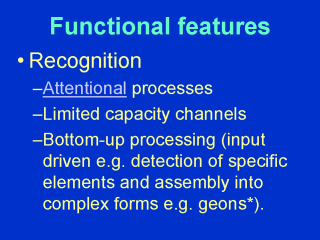| front |1 |2 |3 |4 |5 |6 |7 |8 |9 |10 |11 |12 |13 |14 |15 |16 |review |
 |
Attention is a crucial element
of recognition. Attentional processes are severely disrupted by damage to the inferior
frontal cortex, which, if severe can paralyse a personís capacity to respond to
anything. Attention enables the selection of input for further processing. Research on information processing suggests there is a limited capacity channel which restricts the extent and speed that information can be acquired. For example, using what is known as a binaural listening task (where a person hears two different audio messages in each ear), it can be demonstrated that while the person actively listens to one input, they cannot identify anything other than the most crude features (such as the language spoken) about the message played into the second ear. This indicates that, for any modal input (language, vision, tactile, etc) there is a limit to the extent different information streams can be accessed. This limited capacity feature is probably functionally related to selective attention. (Most ďnormalĒ memory problems arenít problems of memory at all, they are problems of attention: you donít forget - the information never got in in the first place.) Early processing tends to be bottom up, where specific elements of the stimulus pattern, are identified and, for example, assembled into more complex forms, such as geons (geometric templates) (see references). |